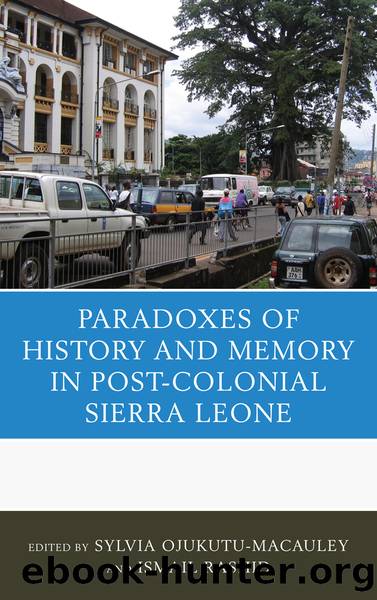The Paradoxes of History and Memory in Post-Colonial Sierra Leone by unknow

Author:unknow
Language: eng
Format: epub
ISBN: 1481214
Publisher: Lexington Books
The Impact of a Weakened Structural Model
Since the establishment of the Battalion, significant structural drawbacks made it difficult to achieve organizational efficiency. Commenting on the performance of the Battalion in the Cameroons campaigns, Brigadier J.J. Moberly argued that it was commendable but not exceptional.49 On the eve of World War II, the Battalion was lagging behind in âstandards,â efficiency,â and, above all, âorganization,â leading the Inspector General to consider it âunfit for war.â Added to these drawbacks, the range of equipment regularly borne by recruits was reputedly âcumbersomeâ and âexcessive.â Of even graver concern before 1939-45 was the lack of anti-gas equipment; so was the practice of denying the Sierra Leone soldier boots, which rendered the replacement of the chupplie necessary. On the eve of World War II, the condition of the rifles and bayonets were in a worn-out state, principally due to the difficulties of fulfilling indents in the United Kingdom for weapons and small arms ammunition. Such difficulties generated administrative complications which hampered the accumulation of reserves of small arms ammunition on the scale specified by the Overseas Defence Committee and adversely affected the Battalionâs efficiency. Thus did the Inspector General conclude that âthe organization ⦠is unsound and in consequence, the training has suffered ⦠and the Battalion is unfit for war.â50
By 1939, the structural weaknesses evident in the imperial model had taken their toll on one distinct segment of Sierra Leone societyâthe Krioâpurveyors of Western education, not only in the dependency but stretching all along the West African coast to Angola.51 Miffed by the refusal of the authorities to respond to their clamor for enlistment and precluded from the profession by a rule against the wearing of boots, Krio aspirations for enlistment had been firmly dented by the time of Gunner Coleâs mutiny in January, 1939.52 The distorted notions held by the British about African recruits, the rather half-hearted commitment to training Sierra Leoneans as officers since 1902, the strict conditions prescribed for entry into Sandhurst Military Academy or Monsâwhich precluded the cultivation of a proper Sandhurst or Mons officer breed by the dawn of independenceâall combined to produce a makeshift structure that hardly suited the needs of independent Sierra Leone. Consequently, the rapid promotion of Sierra Leoneans in the immediate post-independence period helped to produce a distinctively destabilizing effect on the organization. Furthermore, the subsequent substantial closeness in age and the duration of service between the most senior indigenous officers, and the group of substantially younger and probably better educated and trained officers all helped to erode the cohesion and corporate identity of the Sierra Leone Army and enhanced its vulnerability to âoutsideâ influences. As Sierra Leone inherited the recruitment patterns laid down by the British, this ensured the persistence and preservation of the colonial heritage. The armyâs organizational format comprised the colonial infantry battalion as the basic unit, the language of command, internal regulations, terminology, and rank structure, all of which had little in common with the pre-colonial heritage of Sierra Leone society while also precluding any possibility for change.
Download
This site does not store any files on its server. We only index and link to content provided by other sites. Please contact the content providers to delete copyright contents if any and email us, we'll remove relevant links or contents immediately.
| Africa | Americas |
| Arctic & Antarctica | Asia |
| Australia & Oceania | Europe |
| Middle East | Russia |
| United States | World |
| Ancient Civilizations | Military |
| Historical Study & Educational Resources |
Red Famine: Stalin's War on Ukraine by Anne Applebaum(2467)
Chernobyl by Serhii Plokhy(2130)
Midnight in Chernobyl by Adam Higginbotham(2081)
The House of Government by Slezkine Yuri(1846)
Midnight in Chernobyl: The Untold Story of the World's Greatest Nuclear Disaster by Adam Higginbotham(1776)
Red Shambhala by Andrei Znamenski(1751)
The Gulag Archipelago (Vintage Classics) by Aleksandr Solzhenitsyn(1728)
From Cold War to Hot Peace by Michael McFaul(1714)
All the Kremlin's Men by Mikhail Zygar(1700)
Putin's Labyrinth(1661)
Red Notice by Bill Browder(1595)
The Future Is History by Masha Gessen(1592)
From Russia with Lunch by David Smiedt(1552)
A People's Tragedy by Orlando Figes(1545)
The Romanovs by Simon Sebag Montefiore(1490)
How to Tame a Fox (and Build a Dog): Visionary Scientists and a Siberian Tale of Jump-Started Evolution by Lee Alan Dugatkin & Lyudmila Trut(1469)
Putin's Labyrinth: Spies, Murder, and the Dark Heart of the New Russia(1456)
The Lost Spy by Andrew Meier(1399)
Art and Revolution by John Berger(1390)
